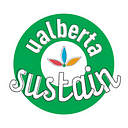Closing the Loop and Opening Minds in the Theatre
Sustainability behind the scenes and in the spotlight in the University of Alberta’s Department of Drama
By Jenna Bell
Call it an indulgence, but I love the theatre. Maybe it’s a way to escape reality, or to simply be entertained. But I love the magic of being transported into a story through the careful combination of acting, lighting, dance, music, costumes, voice and props. It is a unique art form in that the story is crafted live in the moment — creating an incredible intimacy between the actors and audience.
After attending a performance, I sometimes ponder a plotpoint or wonder about a character’s fate — But I’ve never thought about the fate of all the stuff I saw on stage. I never thought about what happens to all the costumes, props and set pieces after the performance is over. I would have assumed that all the materials used in a production will be reused, but this is not the reality in most cases.
“Theatre is notorious for waste,” according to Jeremy Gordaneer, a masters student at the University of Alberta studying theatre design.
As Gordaneer puts it, “the model of theatres is very product-based.” You make a set, you use it for two weeks, and then you trash it and move onto the next thing.
The issue is this: time, money and space. It takes time and money to sort through a set to find salvageable material. It takes expensive real estate to store it. With tight budgets, immovable deadlines and scarce space, theatres often lack the resources to effectively recycle or reuse materials.
“Nobody that works here is okay with chucking all this stuff out, but how do you deal with it?”
“Nobody that works here is okay with chucking all this stuff out,” said Gordaneer. “But how do you deal with it? Nobody has money to rent out a place to store stuff — not even fancy theatre departments.”
Gordaneer is working to reduce waste in the theatre by using only found materials. He showcased this technique as the set designer in the University of Alberta’s 2019 production of Revolt. She Said. Revolt Again.
Using props already existing in storage, he crafted large banners, textural backgrounds and a large facade. Not only was it thrifty, but it helped to reflect the ferocious and discordant messages being staged.
Admittedly, Gordaneer said that his motive was not purely high-minded. “There’s a sustainability aspect to it, because it’s using stuff we already have — we don’t need to make it. But then on a design level, it allows you to do even more because we’re not spending the money [on those materials].”
But what is saved in material cost is lost in labour. Using found materials involves a massive amount of work; from sorting through the props, to creatively envisioning ways to use the pieces in a way that represents the life of the play.
Despite the hurdles, Gordaneer thinks it is possible to produce less waste in theatre if there is more awareness of available materials. “If there was more awareness of what we have already, then maybe people could utilise things that already exist,” said Gordaneer.
A dramatic shift
Sustainability is a topic being more commonly discussed amongst theatre practitioners of all stripes. Even large-scale Broadway productions are more conscientious of their waste. Sustainable businesses are popping up such as SOS Decor in Montreal, which specialize in renting and recycling set pieces. And it’s becoming more common to address environmental issues in the narrative itself.
In November, 2019, University of Alberta drama professors Stefano Muneroni and Selena Couture joined forces to put on a staged reading of Climate Change Theatre Action, a biennial anthology of short climate change plays.
Muneroni and Couture selected two plays to be performed by professional actors (Sandy Nicholls and Doug Mertz). Both pull at the heartstrings. Yvette Nolan’s Breathing Spaces paints a picture of a dystopian future brought on by climate change; Caridad Svich’s A Letter from the Ocean discusses the foreseen loss of human communication across species and elements.
“We wanted to create a space through which the spectators can experience the sense of loss that comes with losing nature and losing Earth as we know it,” Muneroni explained.
The event finished with panelists from the Faculty of Arts discussing the plays and their own involvement with climate change action. Then the audience got to join in. “It became really a conversation with the audience; the audience was really sharing their own response to the plays,” said Muneroni.
The production took place not long after Edmonton’s climate strike with activist Greta Thunberg. Political tension and climate conversations were still lingering in the air, making this topic particularly emotional and thought-provoking. The theatre’s collaborative dynamic made for a particularly effective space to imagine new realities and cleaner, greener futures.
“We can’t imagine how to do things otherwise”
“Even though we’re in the midst of a climate crisis, where theatre doesn’t seem necessary — part of how we’ve gotten here is that we can’t imagine how to do things otherwise,” said Couture.
Immersive experiences can help people better understand the threat of climate change, as well as the potential for solutions. With this production, Couture and Muneroni intended to start a conversation within the fine arts community about climate change, and to bring attention to the kind of sustainability work that’s already happening across the university. And it seems to have worked.
“Theatre can be entertainment, but it’s not just that. I believe that theatre can be a source of communication to provoke social change,” said Muneroni.
As climate change continues to increase in urgency, greater awareness and action will need to take place. So the next time the curtain closes and the roaring of thunderous applause settles — maybe the state of the Earth will be a part of your post-show discussions too.
